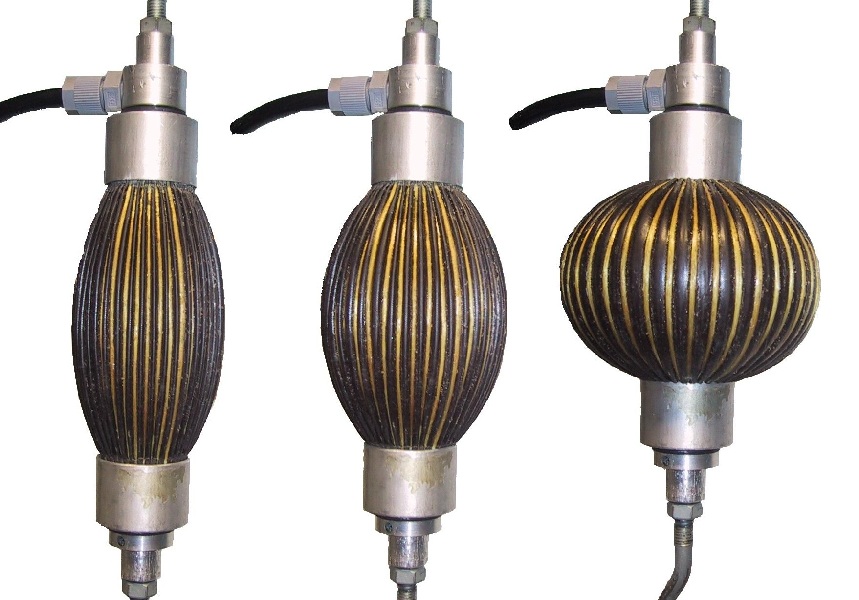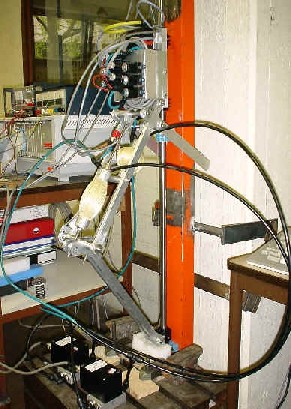Wednesday, March 26, 2008
Roussel's Method
Hopper

A pneumatic artificial muscle is, in essence, a membrane that will expand radially and contract axially when inflated, while generating high pulling forces along the longitudinal axis. Different designs have been developed. The best known is the so called McKibben muscle (example is the Air Muscle of the Schadow Robot Company). This muscle contains a rubber tube which will expand when inflated, while a surrounding netting transfers tension. Hysteresis, due to dry friction between the netting and the rubber tube, makes control of such a device rather complicated. Typical of this type of muscles is a threshold level of pressure before any action can take place. The main goal of the new design was to avoid both friction and hysteresis, thus making control easier while avoiding the threshold. This was achieved by arranging the membrane into radially laid out folds that can unfurl free of radial stress when inflated. The membrane's stiff longitudinal fibres transfer tension. The inflated and deflated state of the Pleated Pneumatic Artificial Muscle are illustrated below.

These artificial muscles have specific properties that are of special interest in the field of legged robots:
- High torque/weight and power/weight ratios
- Muscles’ natural compliance
- The actuator can be positioned at the joint without complex gearing mechanisms
- Adaptable passive behaviour suited for energy storage >
- Shock absorbance during impact.>
The generated force is highly non-linear and proportional to the applied gauge pressure in the muscle. At a pressure of 300 kPa the force can be as high as 4000N for a device with initial length of 10cm, weighing only 100g.
Pneumatic artificial muscles only generate force when they shorten. To have a bi-directional working joint one has to couple two muscles antagonistically. At each joint the muscles are attached in a leverage mechanism by pulling rods. The points of attachment are essential in the design since they determine torque characteristics.
In an antagonistic setup without external load, position will be determined by the ratio of pressures in both muscles. In previous work (Daerden) a revolute joint was build for rotations between -30° and 30°. A step response from 0° to 10° was achieved with end error within 0.1° and overshoot less than 1° making use of proportional valves to control both pressures.
The artificial muscle is inherently compliant due to gas compressibility and the dropping force-contraction curve. In an antagonistic setup compliance is determined by the sum of the pressures in both muscles, therefore both position and stiffness can be controlled.
To investigate this, a hopping mechanism (see picture above) composed of a lower leg, upper leg, hip and body sliding along a guide shaft was built. Only the knee is actuated by a pair of artificial muscles. During experiments the leg was dropped from a fixed height while both muscles were kept closed. During stance, the leg will bend and stretch the extensor muscle. In this muscle, pressure and forces will increase as it extends, which implies that the extensor muscle stores motion energy that will be released as soon as the leg starts straightening. During these tests energy recuperation of up to 30% is registered.
More information on this topic can be found in (Verrelst e.a. clawar 2000)
Saturday, March 22, 2008
Metagrams

"Fort Douglas"
Fort (from www.dictionary.com)
–noun
| 1. | a strong or fortified place occupied by troops and usually surrounded by walls, ditches, and other defensive works; a fortress; fortification. |
| 2. | any permanent army post. |
| 3. | (formerly) a trading post. |
| 4. | hold the fort,
|
| -- noun | |
| 1. | a fortified military post where troops are stationed [syn: garrison] |
| 2. | a fortified defensive structure [syn: fortress] |
verb | |
| 1. | gather in, or as if in, a fort, as for protection or defense |
| 2. | enclose by or as if by a fortification [syn: fortify] |
| 3. | station (troops) in a fort |
from the Oxford English Dictionary:
Noun 1
1. Mil. A fortified place; a position fortified for defensive or protective purposes, usually surrounded with a ditch, rampart, and parapet, and garrisoned with troops; a fortress.
b. fig. A strong position, stronghold. Phr. to hold the fort: to act as a temporary substitute; also, to remain at one's post, to maintain one's position, to ‘cope’.
c. In British North America and parts of the U.S.: A trading station (originally fortified).
2. The place of security (of a wild animal).
4. Strong part or point. Now written FORTE, q.v.
--
Noun 2
1867 FRY Playing-Card Terms in Philol. Soc. Trans. 56 Fort, an oiled sheet, (usually large enough for twenty cards) formerly used in making the stencilling-plate for stencilling the colors of the court-cards or the pips of the other cards.

